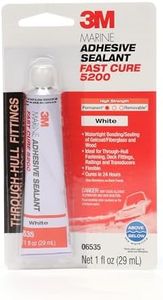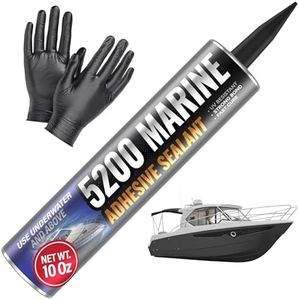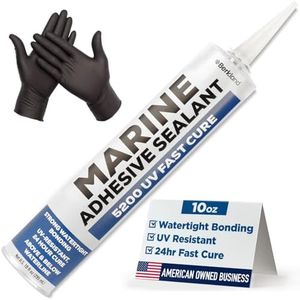10 Best Marine Sealants 2025 in the United States
Our technology thoroughly searches through the online shopping world, reviewing hundreds of sites. We then process and analyze this information, updating in real-time to bring you the latest top-rated products. This way, you always get the best and most current options available.

Our Top Picks
Winner
Sikaflex-221 Multi-Purpose Polyurethane Sealant/Adhesive, 10.1 fl oz, Black – Permanent Elastic Seal, Sandable & Paintable, Non-Corrosive, Bonds to Metal, Plastics & More
Most important from
2562 reviews
The Sika Sikaflex-221 is a versatile, multi-purpose polyurethane sealant that is well-suited for marine applications. Its primary strength lies in its ability to bond to a wide variety of materials including metals, plastics, and ceramics, making it highly adaptable for different uses. The sealant creates a permanent elastic seal that remains flexible, which is crucial for coping with the constant movements and stresses in a marine environment.
Additionally, it is sandable and paintable, allowing for a smooth finish and aesthetic customization after application. Its non-corrosive nature means it won't damage the surfaces it is applied to, and its resistance to aging ensures longevity even under harsh conditions. It also resists seawater, diluted acids, and caustic solutions, making it suitable for diverse marine settings.
Most important from
2562 reviews
3M Marine Adhesive Sealant 5200 - Permanent Bonding and Sealing for Boats and Marine Applications - Black - 3 Ounces
Most important from
9238 reviews
The 3M Marine Adhesive Sealant 5200 is a robust and reliable choice for permanent bonding and sealing in marine applications. This sealant stands out due to its powerful adhesion to various materials such as wood, fiberglass, and metal, making it versatile for a range of marine tasks, including deck housings and porthole mounting.
Its polyurethane polymer composition ensures a durable, yet flexible bond that can handle stress from vibrations, swelling, and shocks, which is essential for the dynamic environment of boats and marine structures. The product boasts impressive resistance to saltwater and weathering, both above and below the waterline, ensuring long-lasting protection against the elements.
It takes about 48 hours to achieve handling strength, offering ample working time for adjustments and refinements during application. However, the curing process may be considered lengthy for those needing faster results. Additionally, while the black color may suit some applications, it might not be ideal for all aesthetic preferences. The 3M Marine Adhesive Sealant 5200 offers strong adhesion, flexibility, and resistance to marine conditions, making it a dependable choice for anyone needing a permanent marine sealant, despite the longer curing time and specific color option.
Most important from
9238 reviews
3M Marine Adhesive Sealant 5200 (06500) Permanent Bonding and Sealing for Boats and RVs Above and Below the Waterline Waterproof Repair, White, 10 fl oz Cartridge
Most important from
9238 reviews
The 3M Marine Adhesive Sealant 5200 is a strong, permanent polyurethane sealant designed especially for boats and RVs, suitable for use above and below the waterline. It excels at bonding common marine materials like wood, fiberglass, and metal, providing a flexible yet tough joint that can handle movement from waves or vibrations. This flexibility helps prevent cracks or breaks over time, making it a reliable choice for sealing hull fittings, portholes, and transoms. Additionally, it resists saltwater and weather effects well, which is crucial for marine environments where UV exposure and chemical exposure are constant concerns.
One important consideration is its curing time—while it allows plenty of working time for careful application, it takes about 48 hours to reach a handling strength, meaning you’ll need to wait before putting your boat back in use. Also, this sealant is intended for professional or industrial use rather than casual consumer application, which might limit its accessibility for some boat owners.
If you need a durable, waterproof sealant with excellent bonding and flexibility for marine repairs or construction, 3M 5200 stands out as a dependable choice, especially when a permanent seal is required and curing time is not a constraint.
Most important from
9238 reviews
Buying Guide for the Best Marine Sealants
Choosing the right marine sealant is crucial for ensuring the longevity and durability of your boat or marine equipment. Marine sealants are used to seal joints, seams, and other areas to prevent water ingress, which can lead to damage and deterioration over time. When selecting a marine sealant, it's important to consider the specific needs of your project, such as the materials you're working with, the environmental conditions, and the type of sealant that will provide the best performance. Here are some key specifications to consider when choosing a marine sealant.FAQ
Most Popular Categories Right Now
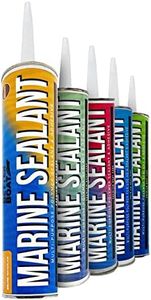


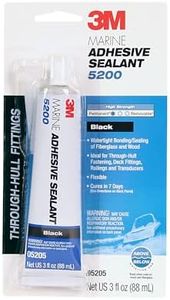
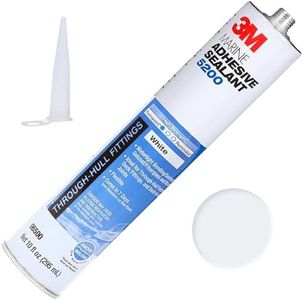



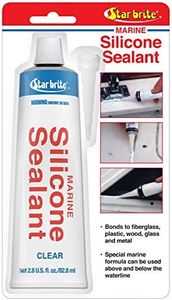


![[Black] 5200 Marine Sealant - Fast Cure, High Bond Strength, UV Resistant Underwater 5200 Fast Cure, Marine Adhesive Sealant for Boats, Hulls, Decks, & RVs Marine Caulk Black with Gloves, Nozzle 3oz](https://images-proxy.bestreviews.guide/psTM7uctwoi1fewAQSRk68ki5Sc=/0x300/https://m.media-amazon.com/images/I/41VFJtUGSsL._AC_CX679_.jpg)


